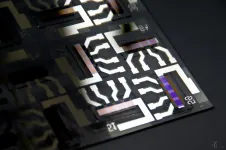CAR T cell therapy is an immunotherapy that has shown great promise for the treatment of some blood cancers; however, the treatment of solid tumours using this therapy has proved very difficult. One barrier to success is toxicity in tissues other than the cancer because most of the proteins currently used to target CAR T cells to pancreatic cancer cells and other solid tumours are present in low levels on other normal tissues, leading to toxic side effects.
In this study, published today in Clinical Cancer Research and funded by the charity Pancreatic Cancer UK, the team identified a protein called CEACAM7 that may represent a safer treatment target for the development of therapies against pancreatic ductal adenocarcinoma (PDAC), the most common type of pancreatic cancer.
By using a specialised technique called immunostaining, the team examined a panel of human PDAC samples, and normal tissues for the presence of CEACAM7. A large subset of PDAC samples tested expressed CEACAM7, but the protein was undetectable in a panel of normal tissues including tonsil, lung, liver, and prostate, suggesting that CEACAM7 may be an ideal target for CAR T cell development against pancreatic cancer.
To determine the potential of CEACAM7 as a treatment target, the team developed CAR T cells targeted to CEACAM7 and applied these to PDAC cell lines as well as a preclinical model of PDAC. The CAR T cells effectively targeted the CEACAM7-expressing cells in PDAC cell cultures, and eliminated cancer cells in a late-stage preclinical model of PDAC.
Professor John Marshall from Queen Mary University of London who led the study, said: "This is an exciting development. Finding that CEACAM7 allows us to kill pancreatic cancer cells specifically with CAR T cells while having no significant toxicity in non-tumour tissues, gives us hope that this strategy could be effective in the future. It is also possible that other types of immune-based therapies could be directed to CEACAM7 for the treatment of pancreatic cancer."
Dr Deepak Raj, postdoctoral researcher and first author of the study, said: "As CEACAM7 is a poorly studied protein thus far, we were excited to find that it appears a promising CAR T-cell target on pancreatic cancer. It would be important to assess a larger number of antibodies against CEACAM7, not only to generate and test a larger panel of CAR T cells that may have increased efficacy against pancreatic cancer, but also to more conclusively rule whether low levels of CEACAM7 are present in normal tissues."
How does CAR T cell therapy work?
CAR T cell therapy utilises immune cells (called killer T cells) from the patient's blood, which have a critical role in the immune response. Killer T cells are first isolated from the patient's blood and modified in the laboratory to express special protein receptors on their surface, called Chimeric Antigen Receptors (CAR), creating CAR T cells. The CAR protein allows the CAR T cells to recognise a specific protein on the surface of cancer cells. CAR T cells are multiplied in the laboratory and then re-injected back into the patient where they recognise and kill cancer cells that have the target protein on their surface.
In this study, the team made a new CAR using part of an antibody to CEACAM7 from collaborator Professor Brad Nelson (British Columbia, Canada). They then modified killer T cells to present this new CAR protein on their surface that recognises and binds to CEACAM7, directing the killer T cells to kill only cells with CEACAM7, and these seem to be only pancreatic cancer cells.
Challenges in the treatment of pancreatic cancer
Pancreatic ductal adenocarcinoma (PDAC) is the most common type of pancreatic cancer and has the lowest survival rate of all the common cancers, as only about 7% of those diagnosed with this cancer type in the UK survive their cancer for 5 years or more. Diagnosis often comes too late due to a lack of definitive symptoms, by which point surgery to remove the tumour - which offers the greatest chance of a cure - is not possible. There is an urgent requirement for new and more effective targeted therapies.
Chris Macdonald, Head of Research at Pancreatic Cancer UK said: "These findings are very encouraging and offer real hope that a new, innovative immunotherapy treatment for pancreatic cancer is on the horizon. For the first time a distinct and specific target protein for pancreatic cancer cells has been identified and, crucially, the brilliant team at Barts have shown that by focusing on it, they can destroy the cancer without damaging healthy tissue. This has never been done before in pancreatic cancer and marks an important step towards a desperately needed new treatment option, which could be both more effective and have fewer side-effects for patients.
Currently treatment options are limited and people affected by this devastating disease face incredibly low odds of survival. I look forward to seeing the results of targeting this protein in future clinical trials. I hope we'll see these findings, along with the other research funded by Pancreatic Cancer UK's Grand Challenge, benefit people with pancreatic cancer, the way we've seen new immunotherapy treatments benefit people with other types of cancer."
INFORMATION:
Notes to Editors
Research paper: CEACAM7 Is an Effective Target for CAR T-cell Therapy of Pancreatic Ductal Adenocarcinoma. Deepak Raj, Maria Nikolaidi, Irene Garces, Daniela Lorizio, Natalia M. Castro, Sabrina G. Caiafa, Kate Moore, Nicholas F. Brown, Hemant M. Kocher, Xiaobo Duan, Brad H. Nelson, Nicholas R. Lemoine, and John F. Marshall. CLINICAL CANCER RESEARCH. DOI: 10.1158/1078-0432.CCR-19-2163 https://clincancerres.aacrjournals.org/content/clincanres/early/2021/01/21/1078-0432.CCR-19-2163.full.pdf
About pancreatic cancer
Less than seven per cent of people with pancreatic cancer will survive beyond 5 years in the UK. (Source: ONS)
Five year survival for pancreatic cancer has improved very little since the early 1970s.
One person dies of pancreatic cancer every hour. Around 8,924 people die every year of the disease in the UK.
At least 60 per cent of people with pancreatic cancer are not diagnosed until the cancer is at an advanced stage.
Surgery is the only treatment which could save lives, yet less than ten per cent of people with pancreatic cancer have it.
Pancreatic cancer has the lowest survival of all the 20 common cancers.
Around 10,000 people are diagnosed with pancreatic cancer per year in the UK. That's 27 people every day.
Pancreatic cancer is the fifth most common cause of cancer death in the UK
(Source: Cancer Research UK)
Pancreatic cancer research has historically been underfunded. The disease attracts just 2.1 per cent of the UK cancer research budget.(Source: NCRI 2016/2017)
About Pancreatic Cancer UK:
Pancreatic Cancer UK is taking on pancreatic cancer through research, support and campaigning to transform the future for people affected.
We provide expert, personalised support and information via our Support Line (Freephone 0808 801 0707) and through a range of publications.
We campaign for change; for better care, treatment and research, and for pancreatic cancer to have the recognition it needs.
We fund innovative research to find the breakthroughs that will change how we understand, diagnose and treat pancreatic cancer.







